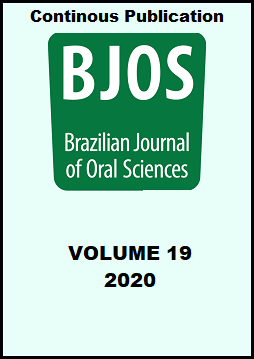Abstract
Aim: this study assessed the patients’ perception of the outcomes of prosthetic treatment in a University of Southern Brazil. Methods: patients seeking for prosthetic treatment were invited to answer a questionnaire with 41 items about the potential risks, benefits, and consequences of no treatment. Answers were obtained according to a five-item Likert-scale varying from 1 (completely disagree) to 5 (completely agree). Sociodemographic data was included in the comparison. Mann-Whitney or Kruskal-Wallis (95%) compared data depending on the variable. Results: two-hundred twenty-five patients answered the questionnaire. Median age of participants was 45-54 years. The potential benefits were similar among participants irrespective of the variable adopted. The perception of risks was significant influenced by variables gender, age, education level, type of edentulous space, prior treatment with prosthodontics, type of prosthodontics, and prosthodontics usage in years. Consequences of no treatment were affected by age, prior treatment with prosthodontics, and prosthodontics usage in years. Conclusions: the study showed the fundamental importance of correct elucidation about the potential risks (negative perception) in the initial appointment for the studied population. Elucidation about the consequences of no treatment are relevant because some differences were seen into the variables. Prosthodontics patients from the city of Passo Fundo seem well informed about the benefits of the prosthetic treatment, besides the significant influence of some sociodemographic and prosthetic conditions.
References
Aarabi G, John MT, Schierz O, Heydecke G, Reissmann DR. The course of prosthodontic patients' oral health-related quality of life over a period of 2 years. J Dent. 2015 Feb;43(2):261-8. doi: 10.1016/j.jdent.2014.09.006.
Alfenas BFM, de Andrade KM, Carletti TM, Cunha R, Garcia MR. Removable prostheses improve oral health-related quality of life and satisfaction of elderly people with rheumatoid arthritis. Bra J Oral Sci. 2020;19:e206652. doi: 10.20396/bjos.v19i0.8656652.
Al-Omiri MK, Karasneh J. Relationship between oral health-related quality of life, satisfaction, and personality in patients with prosthetic rehabilitations. J Prosthodont. 2010 Jan;19(1):2-9. doi: 10.1111/j.1532-849X.2009.00518.x.
Arenas-Márquez MJ, Tôrres LHN, da Silva DD, Hilgert JB, Hugo FN, Neri AL, et al. Validity of self-report of oral conditions in older people. Braz J Oral Sci. 2019;18:e191670. dx.doi.org/10.20396/bjos.v18i0.8657271.
Boscato N, Schuch HS, Grasel CE, Goettems ML. Differences of oral health conditions between adults and older adults: A census in a Southern Brazilian city. Geriatr Gerontol Int. 2016 Sep;16(9):1014-20. doi: 10.1111/ggi.12588.
Divaris K, Polychronopoulou A, Mattheos N. An investigation of computer literacy and attitudes amongst Greek post-graduate dental students. Eur J Dent Educ. 2007 Aug;11(3):144-7. doi: 10.1111/j.1600-0579.2007.00437.x.
Gaspar MG, Dos Santos MB, Dos Santos JF, Marchini L. Correlation of previous experience, patient expectation and the number of post-delivery adjustments of complete dentures with patient satisfaction in a Brazilian population. J Oral Rehabil. 2013 Aug;40(8):590-4. doi: 10.1111/joor.12070.
John MT, Koepsell TD, Hujoel P, Miglioretti DL, LeResche L, Micheelis W. Demographic factors, denture status and oral health-related quality of life. Community Dent Oral Epidemiol. 2004 Apr;32(2):125-32. doi: 10.1111/j.0301-5661.2004.00144.x.
John MT, Slade GD, Szentpétery A, Setz JM. Oral health-related quality of life in patients treated with fixed, removable, and complete dentures 1 month and 6 to 12 months after treatment. Int J Prosthodont. 2004 Sep-Oct;17(5):503-11.
Kumar A, Kothari M, Grigoriadis A, Trulsson M, Svensson P. Bite or brain: Implication of sensorimotor regulation and neuroplasticity in oral rehabilitation procedures. J Oral Rehabil. 2018 Apr;45(4):323-33. doi: 10.1111/joor.12603.
Leles CR, Martins RR, Silva ET, Nunes MF. Discriminant analysis of patients' reasons for choosing or refusing treatments for partial edentulism. J Oral Rehabil. 2009 Dec;36(12):909-15. doi: 10.1111/j.1365-2842.2009.02018.x.
Leles CR, Morandini WJ, da Silva ET, de F Nunes M, Freire MC. Assessing perceived potential outcomes of prosthodontic treatment in partial and fully edentulous patients. J Oral Rehabil. 2008 Sep;35(9):682-9. doi: 10.1111/j.1365-2842.2007.01839.x.
Lemos MMC, Zanin L, Jorge MLR, Flório FM. Oral health conditions and self-perception among edentulous individuals with different prosthetic status. Braz J Oral Sci. 2013 Jan/Mar;12(1):5-10. doi: 10.20396/bjos.v12i1.8641111.
Masella RS. The hidden curriculum: value added in dental education. J Dent Educ. 2006 Mar;70(3):279-83.
Miranda BB, dos Santos MB, Marchini L. Patients' perceptions of benefits and risks of complete denture therapy. J Prosthodont. 2014 Oct;23(7):515-20. doi: 10.1111/jopr.12164.
Moreira RS, Nico LS, Tomita NE. O risco espacial e fatores associados ao edentulismo em idosos em município do Sudeste do Brasil [Spatial risk and factors associated with edentulism among elderly persons in Southeast Brazil]. Cad Saude Publica. 2011 Oct;27(10):2041-54. doi: 10.1590/s0102-311x2011001000017. Portuguese.
Morel LL, Possebon APR, Faot F, Pinto LR. Prevalence of risk factors for denture stomatitis in complete denture wearers. Braz J Oral Sci. 2019;18:e191414. doi: 10.20396/bjos.v18i0.8655147.
Nordenram G, Davidson T, Gynther G, Helgesson G, Hultin M, Jemt T, et al. Qualitative studies of patients' perceptions of loss of teeth, the edentulous state and prosthetic rehabilitation: a systematic review with meta-synthesis. Acta Odontol Scand. 2013 May-Jul;71(3-4):937-51. doi: 10.3109/00016357.2012.734421.
Peres MA, Barbato PR, Reis SC, Freitas CH, Antunes JL. [Tooth loss in Brazil: analysis of the 2010 Brazilian Oral Health Survey]. Rev Saude Publica. 2013 Dec;47 Suppl 3:78-89. doi: 10.1590/s0034-8910.2013047004226. Portuguese.
Reginato VF, Maroli A, Caldas RA, Sánchez-Ayala A, Spazzin AO, Bacchi A. [Relationship between prosthetic factors and oral health-related quality of life in complete denture wearers]. Rev Odonto Cienc 2017;32(2):77-82. doi: 10.15448/1980-6523.2017.2.27486. Portuguese.
Ribeiro MT, Rosa MA, Lima RM, Vargas AM, Haddad JP, Ferreira e Ferreira E. Edentulism and shortened dental arch in Brazilian elderly from the National Survey of Oral Health 2003. Rev Saude Publica. 2011 Oct;45(5):817-23. doi: 10.1590/s0034-89102011005000057.
Steele JG, Ayatollahi SM, Walls AW, Murray JJ. Clinical factors related to reported satisfaction with oral function amongst dentate older adults in England. Community Dent Oral Epidemiol. 1997 Apr;25(2):143-9. doi: 10.1111/j.1600-0528.1997.tb00912.x.
Wolfart S, Müller F, Gerß J, Heyedcke G, Marré B, Böning K, et al. The randomized shortened dental arch study: oral health-related quality of life. Clin Oral Investig. 2014;18(2):525-33. doi: 10.1007/s00784-013-0991-6..
Zembic A, Tahmaseb A, Jung RE, Wiedemeier D, Wismeijer D. Patient-reported outcomes of maxillary edentulous patients wearing overdentures retained by two implants from insertion to 4 years. Int J Oral Maxillofac Implants. 2019 Mar/Apr;34(2):481-8. doi: 10.11607/jomi.6980.
The Brazilian Journal of Oral Sciences uses the Creative Commons license (CC), thus preserving the integrity of the articles in an open access environment.


